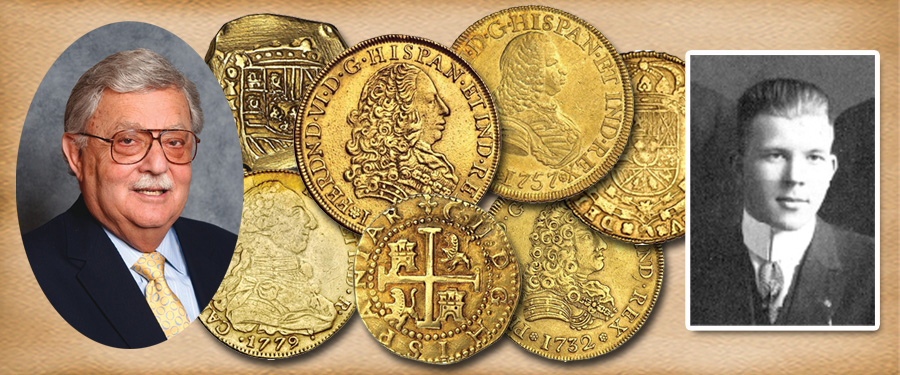
During 1959 and 1960 Stack’s was fortunate to add
to the J.K. Lilly
Collection in various fields. Among
Ancients we found a few double staters of Greece and added to the Aurei of the
Roman Empire, including finding
some very rare examples. We were able to purchase a collection of late Roman and Byzantine coins and filled
in rulers that were not already
a part of the fast growing J.K. Lilly Collection
For Medieval coins we found and acquired early
types from Scandinavia
as well as many new examples of the
hammered coinage of England and
France, and early German pieces. For the milled edge series we were able to locate specimens
representing many of the provinces, states and sovereign countries that were developing monetary systems.
With the help of famous collector Mortimer Hammel,
we
found more doubloons, and smaller
denominations to enhance Mr. Lilly’s fabulous cabinet of Spanish American Colonial coins, the series that
began his interest in gold coins of the world,
Of all of the coins we found and sent to Mr. Lilly,
two coins
stood out as highlights to me, as I
never thought I would have the opportunity to handle them. One was the 100 Ducats
of Poland and the other was the 100 Ducats of Transylvania issued in 1629 on the anniversary of the
rule of Ferdinand, who controlled much of the Holy Roman Empire at that time. These are considered the two largest gold coins
ever issued for use as currency
(mostly by the king or his officials). The examples we found came from
two different European
collections and I was able to deliver them at the same time. When Mr. Lilly picked up and examined each
of the coins, he commented, ” I guess the King had strong leather pockets to carry these in.” He held
them both and laughed at having a “king’s treasure,” one in each hand.
The Lilly Collection of Gold Coins of the World
included
4,500 or more examples. This was a
gigantic feat for any collection,
and it was still growing.
But in every discussion we had, Mr. Lilly wanted to
talk about completing his United States gold collection. He always said he would be patient; but his competitive
collector drive to build a collection of coins nearly as complete as the Eliasberg Collection was always there. While he
might not be able to acquire every U.S. gold coins, he knew that the 1822 half
eagle was a possibility. He knew that three of them were known and that Stack’s
had a promise from Amon Carter,
Jr. that we would have first refusal when he decided to sell it.
One day in the early summer 1960, Amon Carter, Jr.
came into our
shop and said to Ben (the first Stack
to greet him that day), “Are you guys still interested in buying my 1822 half eagle?” Ben responded firmly: “Amon, you know we are!”
“Well, here it is!” He said as he
reached into his lower vest pocket, took out the coin, and placed it on our
counter. By this time the entire
Stack family was in front of the shop. We each looked at it, examined it with a glass, and carefully
returned it to the pad on the counter in front of us.
Of course we asked immediately: “Amon,
how much do you want for it?” Amon, chewing on his cigar, said, ”
I promised you that when I decide to sell it, I would
offer it to you, for your
client, first.” He explained that he and his wife were doing some big
renovations on their home in
Dallas and his wife wanted to re-do the driveway, which was quite long and wide. He finished, “I need
$50,000 for the coin. “
We all gasped! That was by far the highest
price for a gold coin. We responded that the price was quite dear. But our
client had wanted it since we sold him the Weihman collection of half eagles in 1955, hating the “hole” in
his collection. Amon replied:
“Then call him and ask him if he is willing to pay that for the coin!”
So we called Mr. Lilly, told him of the events of
the day and informed him of the asking
price for the coin. There was short silence on the phone, and he then confirmed that there were only three
known, one in the Smithsonian and the other in “that noted Baltimore collection
we have spoke about many times.” He
asked us if we were really looking at it. We answered that it was right on the
desk in front of us. A moment passed and then we heard him say, “I will take
it! I will send a check today!” He then concluded the call thanking us and thanking Mr.
Carter.
We confirmed the purchase and Amon thanked us for
concluding the
deal so smoothly. He got up, lit
another cigar and left with his famous departing words, “Adios, mi amigos. We will do
more together in the future.”
He was a gentleman who kept his word. Years later, while driving from Fort
Worth to the Dallas airport he
had a heart attack and passed away. Within a month Stack’s had a call from his family and
Amon’s executors, to come down to
Dallas, pick up the balance of the Amon Carter Family Collection and offer it for sale at public
auction. Amon had left instructions that if anything happened to him, his coin collection should be auctioned by Stack’s. And that is
just what happened.





